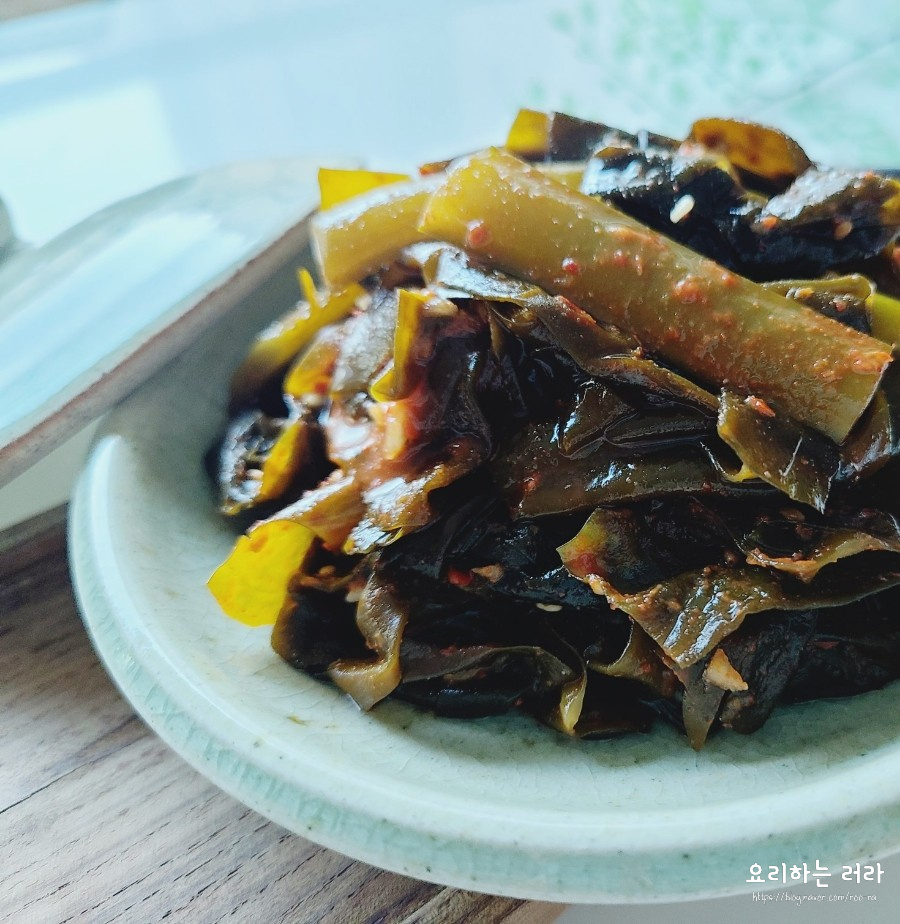Fresh Sea Flavor! Perfectly Prepared Seaweed Salad Without Any Fishiness
Ultimate Guide: How to Make Seaweed Salad Without Fishy or Astringent Taste

Fresh seaweed can sometimes have a fishy or astringent taste because it’s eaten raw. However, with the right preparation, you can eliminate these flavors and enjoy the pure, refreshing taste of the sea. This recipe will show you how to make a delicious seaweed salad with a vibrant, tangy dressing that truly highlights the essence of fresh seaweed. Let’s get started on this delightful seaweed dish!
Ingredients- Fresh seaweed (miyeok) 250g
Seasoning (using Korean rice spoon for measurement)- 1 Tbsp minced garlic
- 1 Tbsp gochugaru (Korean chili flakes)
- 0.8 Tbsp sugar
- 2 Tbsp gochujang (Korean chili paste)
- 2 Tbsp vinegar
- 0.5 Tbsp soup soy sauce (guk-ganjang)
- 1 Tbsp toasted sesame seeds
- 1 Tbsp minced garlic
- 1 Tbsp gochugaru (Korean chili flakes)
- 0.8 Tbsp sugar
- 2 Tbsp gochujang (Korean chili paste)
- 2 Tbsp vinegar
- 0.5 Tbsp soup soy sauce (guk-ganjang)
- 1 Tbsp toasted sesame seeds
Cooking Instructions
Step 1
I’ve purchased a bunch of fresh seaweed. Typically, fresh seaweed is sold with the ‘ear’ part, also known as the ‘gumi’ or root, tied together. If untying this is a hassle, you can easily prepare it while it’s still bound by the rubber band.

Step 2
Place the fresh seaweed, still tied, into a bowl. Sprinkle half a handful of coarse sea salt over it. Gently massage and rub the seaweed with your hands until a light foam forms. This step helps to remove impurities and any potential astringency.

Step 3
After rubbing it with salt, rinse the seaweed thoroughly under running water. Then, sprinkle a little more coarse salt, rub it vigorously again, and rinse. Repeat this process about three to four times. Taste a small piece of the seaweed; continue rinsing until you no longer detect any unpleasant astringent flavor.

Step 4
To ensure there’s no fishy smell, it’s important to blanch the fresh seaweed properly. We’ll start by blanching the thicker stems first. Bring a generous pot of water to a rolling boil, adding half a handful of coarse sea salt. Once boiling, cut below the rubber band holding the seaweed bunch and place the stems into the boiling water to blanch.

Step 5
The thicker stem parts can sometimes be tough or astringent. To ensure tenderness, it’s best to trim a bit from the bottom part where it was tied. Using a knife is safer than scissors for this task.

Step 6
Drape the seaweed leaves over the side of the pot while the stems blanch in the water. Let the stems blanch for about 30 seconds. Then, submerge the rest of the seaweed leaves into the boiling water and blanch for another 30 seconds, or until they turn a vibrant green. Be careful not to overcook, as the seaweed can become mushy.

Step 7
Once blanched, quickly rinse the fresh seaweed under cold running water. Crucially, use both hands to firmly squeeze out as much excess water as possible. Properly draining the seaweed is key to absorbing the dressing well and achieving a delicious final dish.

Step 8
Cut the water-squeezed seaweed into bite-sized pieces. Place them in a bowl and mix with the prepared seasoning – and your delicious seaweed salad is ready! For reference, the initial weight of the seaweed was about 600g, and after preparation, I used 250g for this salad. The remaining seaweed can be used to make a delicious seaweed soup.

Step 9
Now, combine the seaweed with the seasoning ingredients listed in the recipe. Gently but firmly mix everything together with your hands. Since the saltiness and sweetness of gochujang can vary by brand, it’s advisable to start with slightly less sugar and soup soy sauce than the recipe calls for, and adjust to your taste. You can also adjust the amount of vinegar to your preference.

Step 10
This seaweed salad is meant to be enjoyed for its cool, refreshing, and clean taste. Therefore, to preserve the fresh sea flavor, we typically don’t add sesame oil or perilla oil, which would add a nutty aroma. The focus is on the natural taste of the seaweed.

Step 11
Unlike dried seaweed, which has a more savory depth, fresh seaweed offers a vibrant taste of the ocean that feels truly special. It’s a delightful way to enjoy seafood!

Step 12
The texture is wonderfully chewy and slightly crisp, much more so than rehydrated dried seaweed. This fresh seaweed salad is exceptionally delicious when served chilled after being refrigerated. Give it a try!



